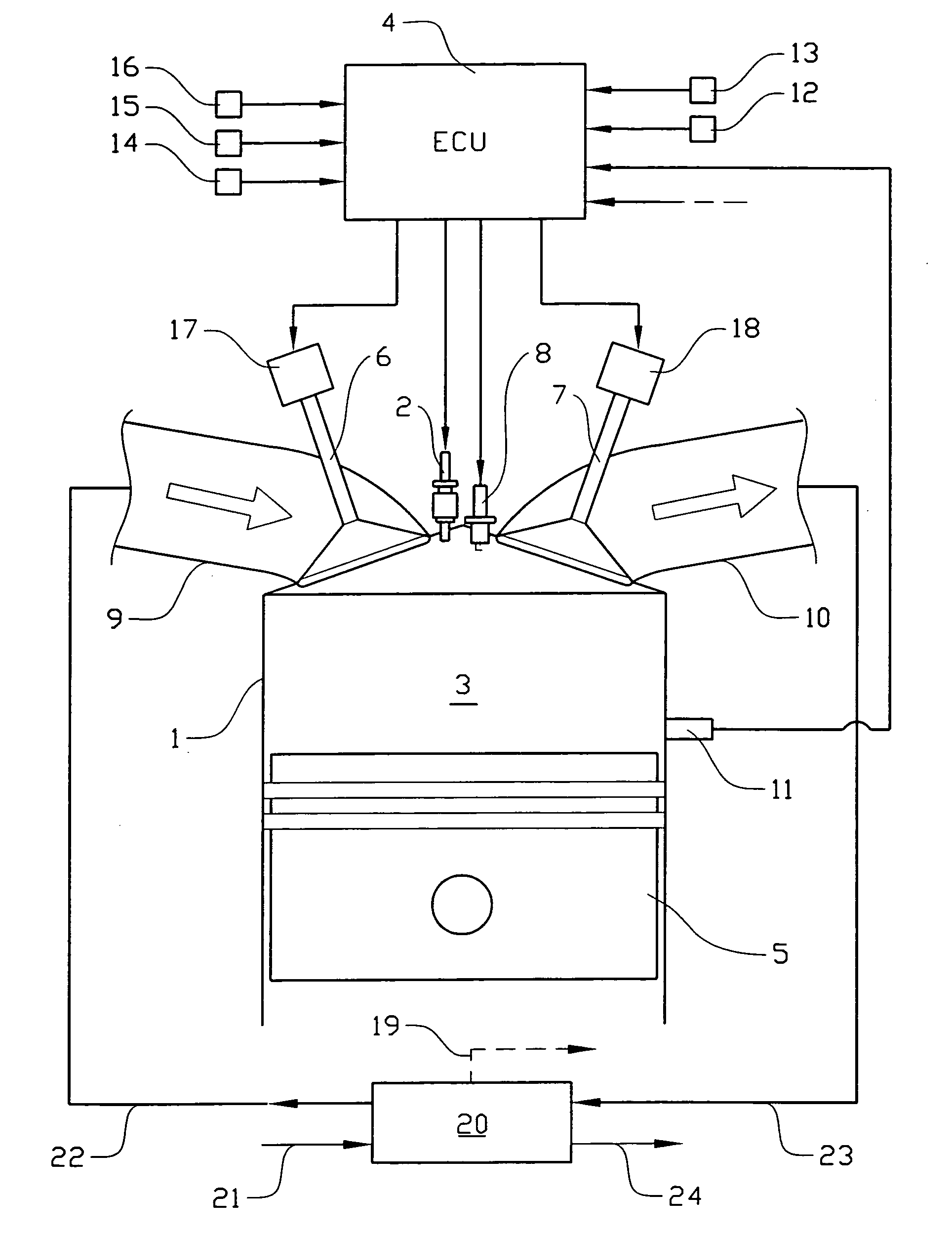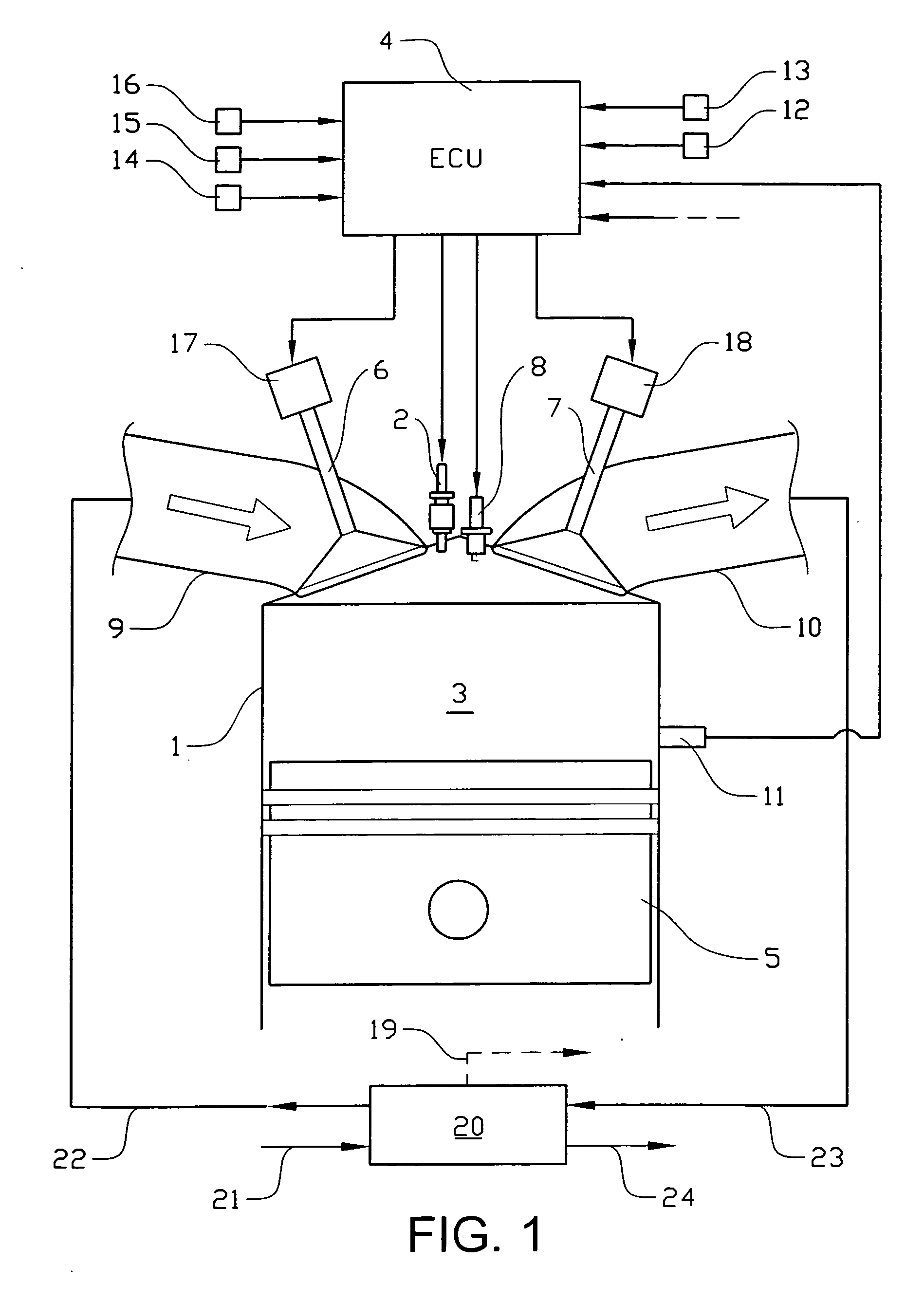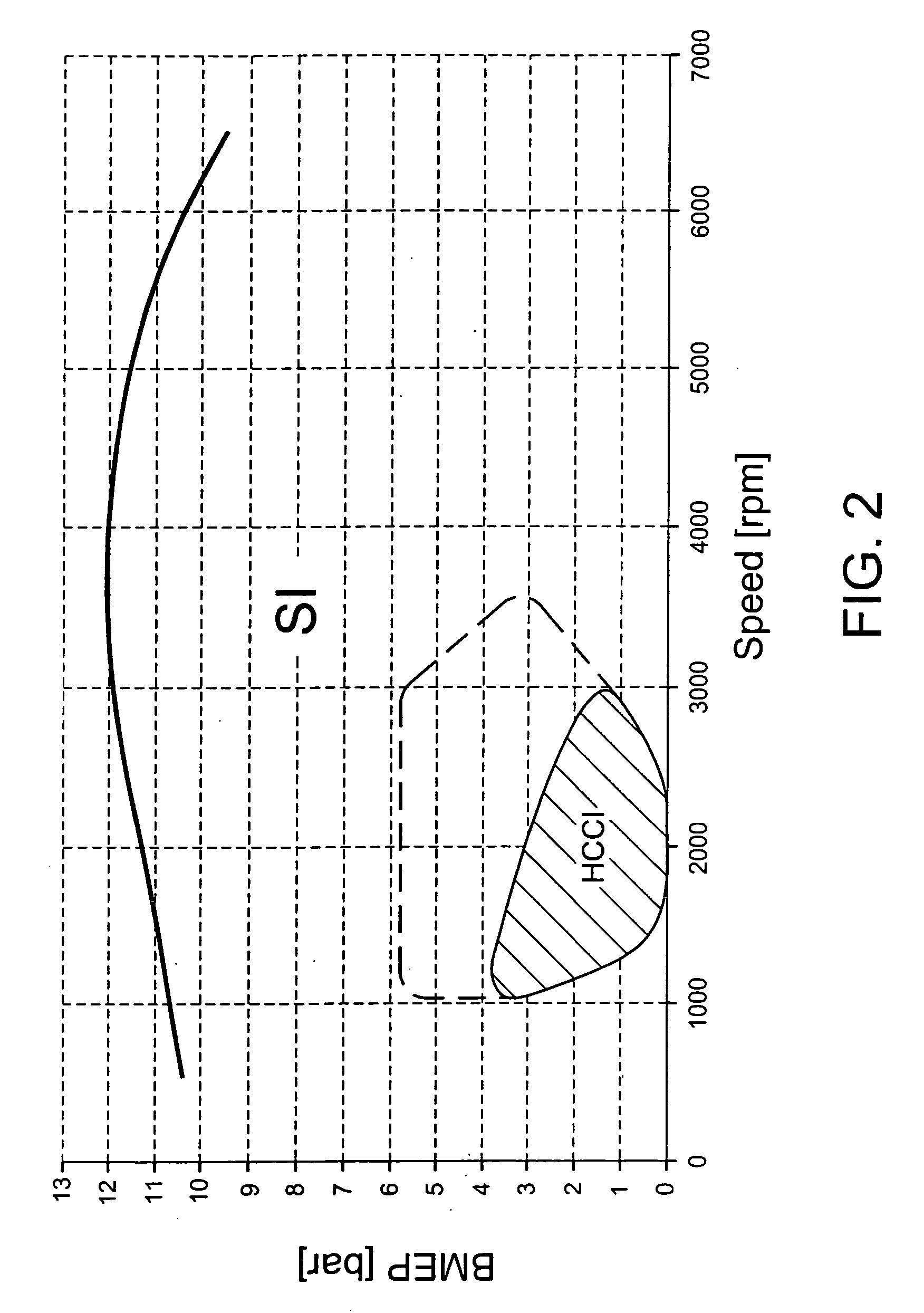[0002] To improve
thermal efficiency of
gasoline internal combustion engines,
lean burn is known to give enhanced thermal efficiency by reducing pumping losses and increasing ratio of specific heats. Generally speaking, lean burn is known to give low fuel consumption and low
nitrous oxide, or
NOx emissions. There is however a limit at which an engine can be operated with a lean air / fuel mixture because of misfire and
combustion instability as a result of a slow burn. Known methods to extend the lean limit include improving ignitability of the mixture by enhancing the fuel preparation, for example using atomised fuel or vaporized fuel, and increasing the
flame speed by introducing charge motion and turbulence in the air / fuel mixture. Finally, combustion by auto-ignition, or
homogeneous charge compression ignition, has been proposed for operating an engine with very lean or diluted air / fuel mixtures. A lean air / fuel mixture has a
lambda value of λ>1. By definition, a
lambda value λ less than 1 is termed “rich”, while a value greater than 1 is termed “lean”. The lambda value is defined as the quantity of intake air divided by the theoretical air requirement, where the ideal stoichiometric air / fuel ratio (14.5 parts air and 1 part fuel) has a lambda value of λ=1.
[0003] When certain conditions are met within a homogeneous charge of lean air / fuel mixture during
low load operation,
homogeneous charge compression ignition can occur wherein bulk combustion takes place initiated simultaneously from many ignition sites within the charge, resulting in very stable
power output, very clean combustion and high
fuel conversion efficiency. NOx emission produced in controlled homogeneous charge compression ignition combustion is extremely low in comparison with spark ignition (SI) combustion based on propagating
flame front and homogeneous charge compression ignition (HCCI) combustion based on an attached
diffusion flame. In the latter two cases represented by
spark ignition engine and
diesel engine, respectively, the burnt gas temperature is highly homogeneous within the charge with very high local temperature values creating high NOx emission. By contrast, in controlled homogeneous charge compression ignition combustion where the combustion is uniformly distributed throughout the charge from many ignition sites, the burnt gas temperature is substantially homogeneous with much lower local temperature values resulting in very low NOx emission.
[0004] Engines operating under controlled homogeneous charge compression ignition (HCCI) combustion have already been successfully demonstrated in two-
stroke gasoline engines using a conventional
compression ratio. The high proportion of burnt gases remaining from the previous cycle, i.e., the residual content, within the two-
stroke engine
combustion chamber is responsible for providing the hot charge temperature and active fuel radicals necessary to promote homogeneous charge compression ignition in a very lean air / fuel mixture. In four-stroke engines, because the residual content is low, homogeneous charge compression ignition is more difficult to achieve, but can be induced by heating the intake air to a high temperature or by significantly increasing the
compression ratio. This effect can also be achieved by retaining a part of the hot
exhaust gas, or residuals, by controlling the timing of the intake and exhaust valves.
[0006] In order to extend the operating range of an engine operated in HCCI-mode the
intake pressure can be boosted by means of a
turbocharger or a compressor. This allows the operating range, or operational window, to be extended. However, when switching between a combustion mode using a higher manifold pressure (charged or boosted) to a combustion mode using a lower manifold pressure (ambient or throttled), a problem arises in evacuating the excess air in the manifold in a very short time. In normal SI-mode the engine operates at or near a lambda value of λ=1 and a leaner combustion, as used in HCCI-mode, could give problems in combustion stability and or exhaust
after treatment e.g. NOx emissions. Secondly, a
mode change should occur as fast as possible in order to avoid intermediate combustion
modes that are difficult to control.
[0014] According to one example, the engine is possible to be operated in homogeneous charge compression ignition (HCCI) combustion mode. In the subsequent text, this will be referred to as HCCI-mode or compression ignition mode. This is a combustion mode, different from a conventional spark ignition (SI) combustion mode, used in order to reduce fuel consumption in combination with ultra low NOx emissions. In this mode, a mixture containing fuel, air and combustion residuals is compressed with a compression ratio between 10.5 and 13 to
auto ignition. The
HCCI combustion has no or a very slow moving flame front, in contradiction to a SI combustion that has a moving flame front. The lack of a flame front reduces temperature and increases the heat release rate, which in turn increases the thermal efficiency of the combustion. The stoichiometric mixture must be diluted with access air and or residuals in order to reduce the heat release rate. This reduces both pumping losses and combustion temperature hence the fuel consumption compared to an SI operated engine. The combustion residuals are captured when operating the engine with a negative valve overlap. Residuals increase the temperature of the mixture so that the
auto ignition temperature is reached before
piston top
dead centre (TDC) and dilute the mixture so that the heat release rate decreases to an acceptable level. By controlling the heat release, cycle-to-cycle variations (COV),
noise and knocking combustion can be reduced. The negative valve overlap is achieved when the
exhaust valve is closed before
piston TDC and the
inlet valve is opened after
piston TDC in the
gas exchange phase of the combustion.
 Login to View More
Login to View More  Login to View More
Login to View More 


